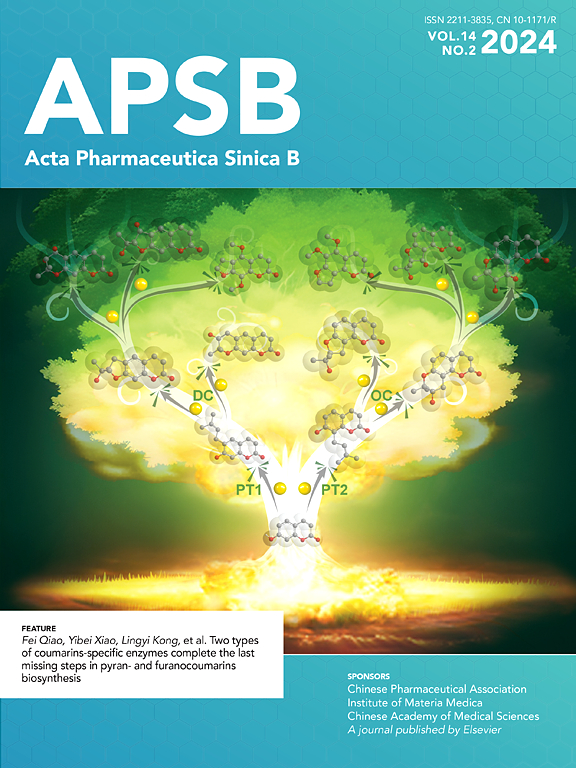从神经毒素GsMTx4中提取的合成肽,作为一种非阿片类镇痛药,通过TRPV4通道减轻机械性和神经性疼痛
IF 14.7
1区 医学
Q1 PHARMACOLOGY & PHARMACY
引用次数: 0
摘要
机械性疼痛是临床疼痛最常见的原因之一,但对于使人衰弱的机械性和慢性神经性疼痛,仍然缺乏有效的治疗方法。近年来,神经毒素GsMTx4作为一种选择性机械敏感(MS)通道抑制剂被发现是有效的,但其作用机制尚不明确。在这里,通过多种啮齿动物疼痛模型,我们证明了基于gsmtx4的17-残基肽,我们称之为P10581,能够减轻机械性痛觉过敏和神经性疼痛。在动物模型中,P10581的镇痛作用与吗啡一样强,但没有毒性。该肽的抗痛觉作用对纳洛酮(一种μ-阿片受体拮抗剂)具有抗性,无吗啡的副作用,包括耐受性、运动障碍和条件性位置偏好。P10581在异质表达系统中对TRPV4的药理抑制,结合TRPV4敲除小鼠的使用,提示TRPV4通道可能是P10581镇痛作用的潜在靶点。我们的研究发现了一种治疗机械性疼痛的潜在药物,并揭示了其作用机制。本文章由计算机程序翻译,如有差异,请以英文原文为准。

A synthetic peptide, derived from neurotoxin GsMTx4, acts as a non-opioid analgesic to alleviate mechanical and neuropathic pain through the TRPV4 channel
Mechanical pain is one of the most common causes of clinical pain, but there remains a lack of effective treatment for debilitating mechanical and chronic forms of neuropathic pain. Recently, neurotoxin GsMTx4, a selective mechanosensitive (MS) channel inhibitor, has been found to be effective, while the underlying mechanism remains elusive. Here, with multiple rodent pain models, we demonstrated that a GsMTx4-based 17-residue peptide, which we call P10581, was able to reduce mechanical hyperalgesia and neuropathic pain. The analgesic effects of P10581 can be as strong as morphine but is not toxic in animal models. The anti-hyperalgesic effect of the peptide was resistant to naloxone (an μ-opioid receptor antagonist) and showed no side effects of morphine, including tolerance, motor impairment, and conditioned place preference. Pharmacological inhibition of TRPV4 by P10581 in a heterogeneous expression system, combined with the use of Trpv4 knockout mice indicates that TRPV4 channels may act as the potential target for the analgesic effect of P10581. Our study identified a potential drug for curing mechanical pain and exposed its mechanism.
求助全文
通过发布文献求助,成功后即可免费获取论文全文。
去求助
来源期刊

Acta Pharmaceutica Sinica. B
Pharmacology, Toxicology and Pharmaceutics-General Pharmacology, Toxicology and Pharmaceutics
CiteScore
22.40
自引率
5.50%
发文量
1051
审稿时长
19 weeks
期刊介绍:
The Journal of the Institute of Materia Medica, Chinese Academy of Medical Sciences, and the Chinese Pharmaceutical Association oversees the peer review process for Acta Pharmaceutica Sinica. B (APSB).
Published monthly in English, APSB is dedicated to disseminating significant original research articles, rapid communications, and high-quality reviews that highlight recent advances across various pharmaceutical sciences domains. These encompass pharmacology, pharmaceutics, medicinal chemistry, natural products, pharmacognosy, pharmaceutical analysis, and pharmacokinetics.
A part of the Acta Pharmaceutica Sinica series, established in 1953 and indexed in prominent databases like Chemical Abstracts, Index Medicus, SciFinder Scholar, Biological Abstracts, International Pharmaceutical Abstracts, Cambridge Scientific Abstracts, and Current Bibliography on Science and Technology, APSB is sponsored by the Institute of Materia Medica, Chinese Academy of Medical Sciences, and the Chinese Pharmaceutical Association. Its production and hosting are facilitated by Elsevier B.V. This collaborative effort ensures APSB's commitment to delivering valuable contributions to the pharmaceutical sciences community.
 求助内容:
求助内容: 应助结果提醒方式:
应助结果提醒方式:


